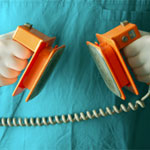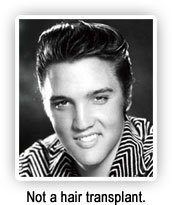Sir,
I am 58 and starting to lose my hair front and top.
I have never used any product other than Nioxin, (for 20 years) but not for hair loss, I simply like the products.
I am having a very hard time, not only believing in the infomercial hair loss products like Provillus but also your negativity towards all these products. I find your foot print, disclaiming most of the infomercial hair loss products and this includes Rogaine…
Should I believe that all these products are completely bogus OR are you degrading them because you charge an insane amount of money for your hair transplants, especially in Calif where the fruits, nuts and very vain people live! I seem to feel that you are bias towards these products because you need to buy another million dollar mansion some where in the fruit and nut state? Am I correct?
By the way, I have many friends that live in Calif and I consider them to be fruits and nuts also!
Sincerely,
– Name removed
New York

 I’ll just assume you were making a very poor attempt at humor with all your “fruits and nuts” comments, so I won’t take offense. Considering our fees for hair transplants are lower than many physicians in your own state, you’re pretty narrow-sighted to think pricing is outrageous because we’re in California. But let’s get to the real meat of your oh-so-insightful email…
I’ll just assume you were making a very poor attempt at humor with all your “fruits and nuts” comments, so I won’t take offense. Considering our fees for hair transplants are lower than many physicians in your own state, you’re pretty narrow-sighted to think pricing is outrageous because we’re in California. But let’s get to the real meat of your oh-so-insightful email…
Most of the hair loss products you read about on the web are bogus and the makers prey on desperate people trying to retain their hair. The products that do work (and are proven to do so) are finasteride and minoxidil. And even then, I post plenty of reports from readers about side effects and concerns for those medications. I like to think I’m pretty balanced when it comes to this stuff. If you like a particular hair product then by all means continue using it. I never said these products were unhealthy or would hurt or kill you. A product like Provillus just contains minoxidil, so it works like minoxidil does. If you want to spend more on a boutique minoxidil with vitamins that I feel won’t aid in regrowth, that’s your call to make. If you want to buy a shampoo because you like the way it makes your hair feel, then please go for it.
It sounds like your biggest gripe is that I’m not writing positive things about unproven treatments. I’m asked about nearly every hair treatment product under the sun, and all I can do with most of these is review the ingredients listed and give my 2 cents. Recently I was asked about a product that lists rosemary as some kind of hair growth treatment. Simon and Garfunkel might’ve had a hit with Parsley, Sage, Rosemary and Thyme, but it doesn’t mean those same ingredients will work to grow hair (otherwise I’m sure Garfunkel wouldn’t have had his infamously bad hairline). My point is that there are hundreds of products around that claim to work — and they simply don’t. There’s no proof that they are effective… and it seems people don’t tend to care if there’s proof, as long as the website looks slick and they’re offered a “guarantee” that may or may not be worth anything.
You’re free to believe what you want to believe about me, but you couldn’t be more wrong. If I was going to try to persuade people into getting surgery, I wouldn’t bother recommending any medication (which I don’t make money on). If I was trying to buy a “million dollar mansion” (actually, it would be my first), I wouldn’t offer my services, time, and support for free through this website. Why would I bother educating people about how to be a better consumer if I was trying to take advantage of them? Give me a break. As for the so-called “fruits and nuts” in California, this state has some of the most normal, driven and brightest people in the world. If you want more information on what this state has to offer, you can visit the California Tourism site. I found that site by using Google… which incidentally was founded in *surprise, surprise* California.

 Short answer — the risk is extremely minimal, at nearly zero. Hair transplants are a surgical procedure and if your doctor did not know what he is doing, you could die. There is one case report of a death during a hair transplant from a couple years back, which I wrote about before.
Short answer — the risk is extremely minimal, at nearly zero. Hair transplants are a surgical procedure and if your doctor did not know what he is doing, you could die. There is one case report of a death during a hair transplant from a couple years back, which I wrote about before.
 I’ll just assume you were making a very poor attempt at humor with all your “fruits and nuts” comments, so I won’t take offense. Considering
I’ll just assume you were making a very poor attempt at humor with all your “fruits and nuts” comments, so I won’t take offense. Considering  The donor area starts at the base of the skull (feel the prominent bone on the bottom of the skull) and go up a distance of 2.5-3 inches high. That is the donor area (see Norwood 7 art at right).
The donor area starts at the base of the skull (feel the prominent bone on the bottom of the skull) and go up a distance of 2.5-3 inches high. That is the donor area (see Norwood 7 art at right).